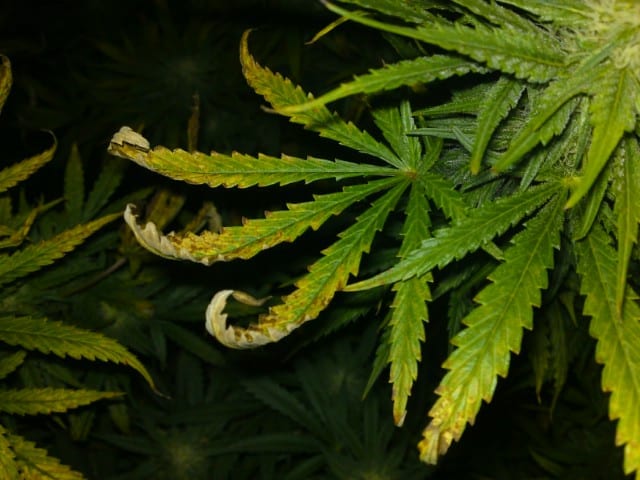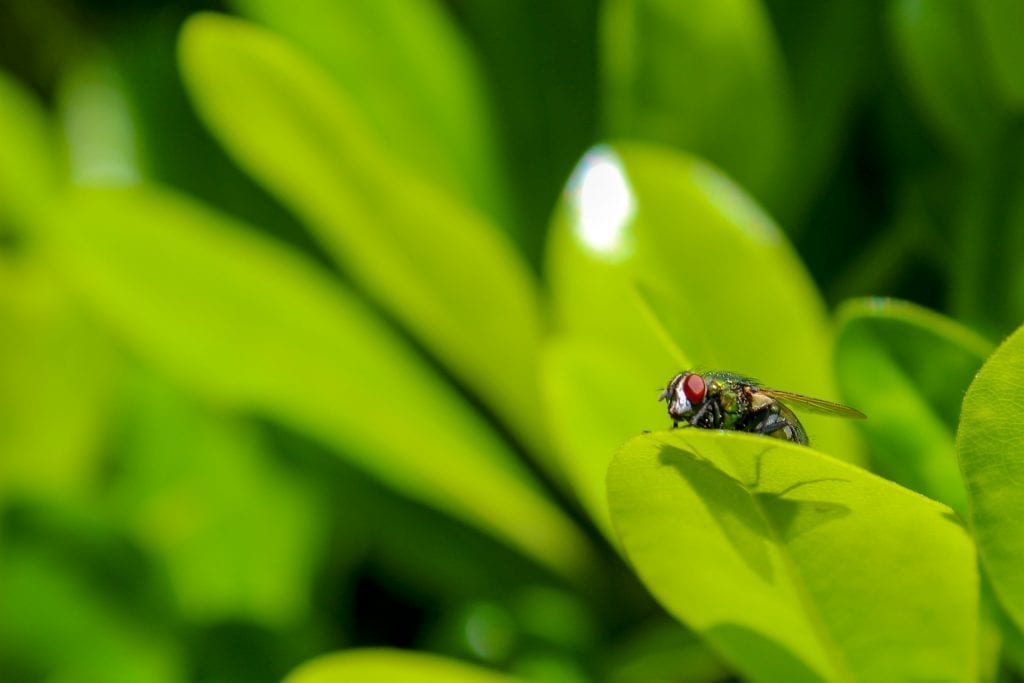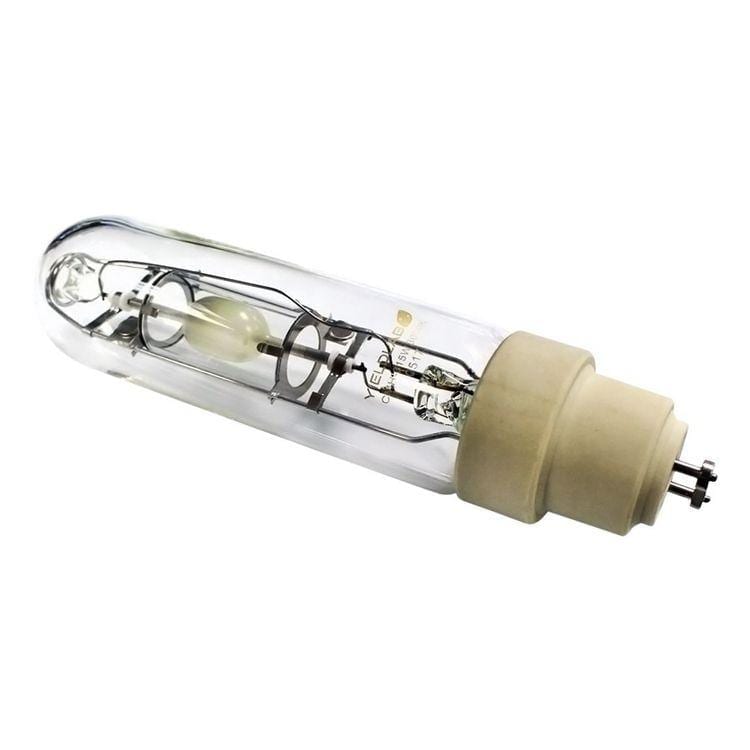Marijuana attracting pests, bugs and viruses are a common affliction that every grower faces. Tiny but parasitic creatures have devastating effects on entire crops, which is they must be identified, controlled and eliminated accordingly. This guide helps in managing various types of pests, bugs and viruses affecting plant growth.
Whilst cultivating you’ll notice a wide array of critters like caterpillars, whiteflies, aphids, fungus gnats, mosaic Virus, thrips, black flies, spider mites, stem rot, white powdery mold, ants, moths and others.
Are you looking for LED grow lights? We reviewed the best lights in the market and put them together in various lists. For example, check out the best 600 watt, 1000 watt or 2000 watt LED grow lights. We also reviewed lots of tools like PAR light meters, bud trimmers and grow tents.
Pests, Bugs and Viruses – A Complete Guide
We’ve constructed a comprehensive guide that will help you to reduce the risk of destruction of your indoor garden. Not only will it help you identify dangerous creatures but also teach you preventative and reactive measures to save your plants.
1. Fungus Gnats
The stems and roots of your plants will be vulnerable to fungus gnats in both the microscopic and larval stages. Eating all the way down to the root system they stunt growth and disturb structural stability by leaching out essential nutrients. Adults carry fungal diseases and lay hundreds of deadly eggs.
Identification:
- Leaf edge burnt;
- Yellowing between leaves;
- Spots and curling leaves;
- Wilting and dropping.
Prevention:
Place a sticky pad near your cannabis plant to catch the larvae. Then mix up water and hydrogen peroxide to form a solution that should be rubbed onto the area where the gnats are located.
2. Aphids
Tiny, pale and existing as black, red, brown, green or yellow, they prove to be a challenging nemesis owing to their minuscule size of 1-10mm. Normally clinging to the underside of leaves, these winged cannabis pests thrive in 60F-80F temperatures. Defoliation and yellowing of leaves is the result of their feeding patterns.
The honeydew substance they excrete causes sooty mold growth turning plants black. Moreover, they are vectors for disease and reproduce at an astonishingly rapid rate causing a negative overall domino effect.
Identification:
- Yellowing leaves;
- Overall plant wilting;
- Clusters or colonies near buds, new growth, and leaf underside.
Prevention:
- Wasps, aphid midges and ladybugs are natural destroyers.
- Organic, homemade tomato leaf sprays or organic garlic oil sprays. Fatty acid salts or insecticidal soaps disrupt insect cell membranes.
- Organic insecticides like Spinosad.
- Essentria IC3 insecticide includes horticulture oils.
3. Caterpillars
Seemingly harmless in everyday life, these bugs end up as a deadly plague for your weed operation. They possess a voracious appetite and are hard to detect unless significant damage is already done.
“Borer” (Hemp and Corn Borer) species have the habit of burrowing into the delicate interior of plants and eating the marrow inside the stalk causing stem canker, hollowing them. They have a predilection for flowering plants.
Identification:
- Chew Marks on Leaves;
- Holes with brown tails on the plant;
- Yellowing on top leaves.
Prevention:
- Parasitic wasps: larvae feed on caterpillars;
- Praying Mantis;
- Cut the bottom train of the ruined stalk;
- Neem oil sprays at night;
- Baccilus thuringiensis: a bacterium marketed as a biological insecticide;
- Avoid letting butterflies and moths into your habitat.
4. White Fly
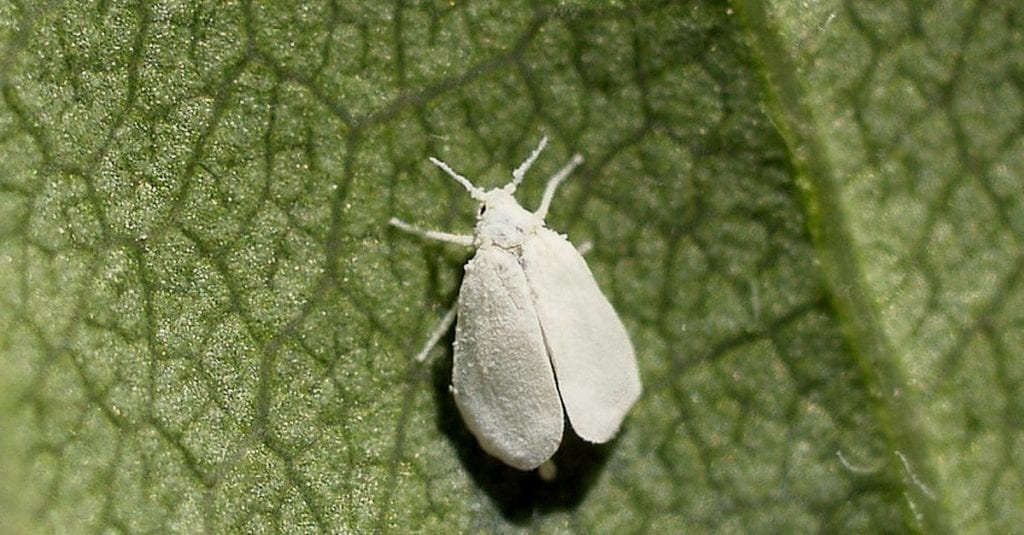
Another common cannabis pest is the poliphagus alurrodide that is about 2mm and yellowish-white. They are referred to as a double-edged sword as they infiltrate your grow room with their mobility and virus spreading propensity.
They portray a high tendency to develop resistance against chemical pesticides, making them a persistent nuisance. The greenhouse, sweet potato, and silverleaf are the most notorious and normally conceal themselves under marijuana leaves.
Able to fly great distances, they distribute honeydew and other viruses, sucking sap from leaves and their droppings stimulate fungus like blush or boldface to sprout. Coupled with their out of control breeding is their invasion ability all year round and in varying temperatures, in a protected crop situation they are defended against natural deterrents like climate and other critters and their genetic resistance.
Identification:
- The weakening of plants and spots on leaves (Chlorosis deficiency);
- Leaves turn yellow, dry up and fall off after white spot formation;
- Shake the plant to see a flock of winged white dust.
Prevention:
- Companion planting: planting Zinnia along your crop will push them out;
- Hummingbirds, predatory wasps, and flies prey on them;
- Plants like Bee Balm, Hummingbird Bush, and Pineapple sage hide the scent of plants that attract whiteflies;
- Oil spray and garlic oil sprays;
- Fatty acid salts, insecticidal soap, potassium soap;
- Neem Oil;
- Lay yellow adhesive tapes.
5. Spider Mites
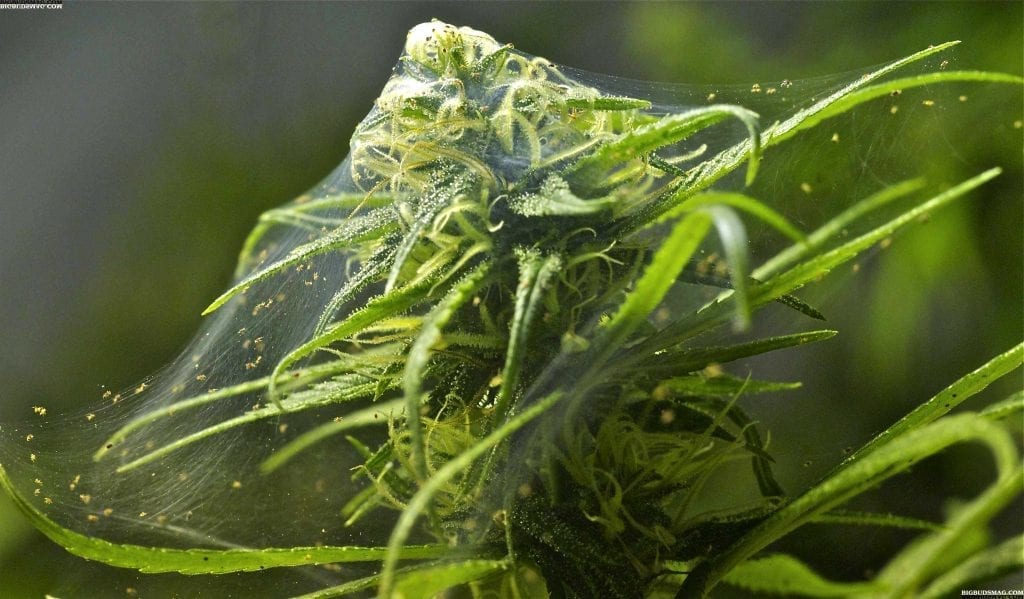
Popularly referred to as “The Borg” in the marijuana industry, bad infestations of Spider Mites are rapid killers and highly adaptable to chemical prevention methods. Two-spotted spider mites, in particular, are very resilient against insecticides.
Your foliage may be susceptible to quick maturing and rapidly reproducing Mites. They drain plant nutrients and suck out chlorophyll, disrupting life-sustaining photosynthesis causing eventual death.
Identification:
- Conduct routine leaf inspections for sickliness, discoloration and slowed growth;
- Fine white strings of webs will be noticeable on the underside of leaves;
- Sticky white silk formations: mottling or mosaic pattern;
- Yellow or white spot coloration on leaves caused by feeding.
Prevention:
- Organic compost mulch adds beneficial predators.
- Do not bring plants from outside into your grow room; marijuana plants or clones brought in should be first quarantined for 2-3 weeks;
- Remove old dead leaves from the surrounding area;
- Ladybirds prey on them;
- Use a hard water spray for 3 consecutive mornings;
- Use a handheld vacuum cleaner to suck them out;
- Beach solutions;
- Homemade pepper sprays;
- Alcohol and water and nicotine tea;
- Create cool environment; increase air circulation;
- Azamax, Spinosad products and Essentria IC3.
6. Thrips
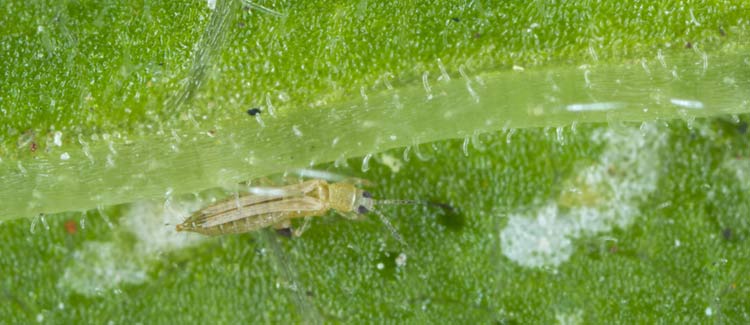
Thrips are 0.06 inch winged creatures that pierce cannabis leaves, extracting nutrients and depositing slimy, silver or bronze spots on the bitten area. Frankliniella occidentalis species particularly affect indoor crops.
Identification:
- Silver marks and dots on leaves;
- Cholorphyll deficiency (dry, brown and brittle plants);
- Burnt edges.
Prevention:
- Misting plants with a solution when lights are off to prevent plant burn;
- Amblyseius cucumeris;
- Wasps, predatory mites and Neem Oil;
- Compost composition of nematodes;
- Place blue adhesive traps;
- Pyrethrins and insecticidal soap.
7. Leaf Miners

This insect burrows between the epidural layers and empties the plant. This is a generic term for larvae that infiltrate cannabis shrubberies.
Identification:
- Squiggly brown or grey lines on leaves;
- Dry patches on the leaf.
Prevention:
- Parasitic wasps;
- Pressing the leaves together to crush them;
- Yellow sticky tape attracts and kills adult flies;
- Remove affected leaves;
- Spinosad;
- Neem Oil;
- If moth or caterpillar larvae then use BT spray.
8. Cutworms
Overnight destruction of marijuana seedlings is a cutworm purpose. 2”, soft-bodied with brown or gray color, these are part of the moth species. They are light sensitive and prey on weaker crops.
Identification:
- Pull up loose soil around damaged plants, tiny balled-up rolls are cutworms;
- Tops of seedlings look cut off;
- Tilting over and wilting.
Prevention:
- Till the soil to reveal cutworms, when planting seedlings make sure no grass or weed;
- Co-planting sunflowers will distract cutworms from marijuana plants;
- Drown with buckets filled with water, soap or gasoline;
- Parasitic wasps and frogs;
- Sprinkle indigestible cornmeal.
9. Red Spider
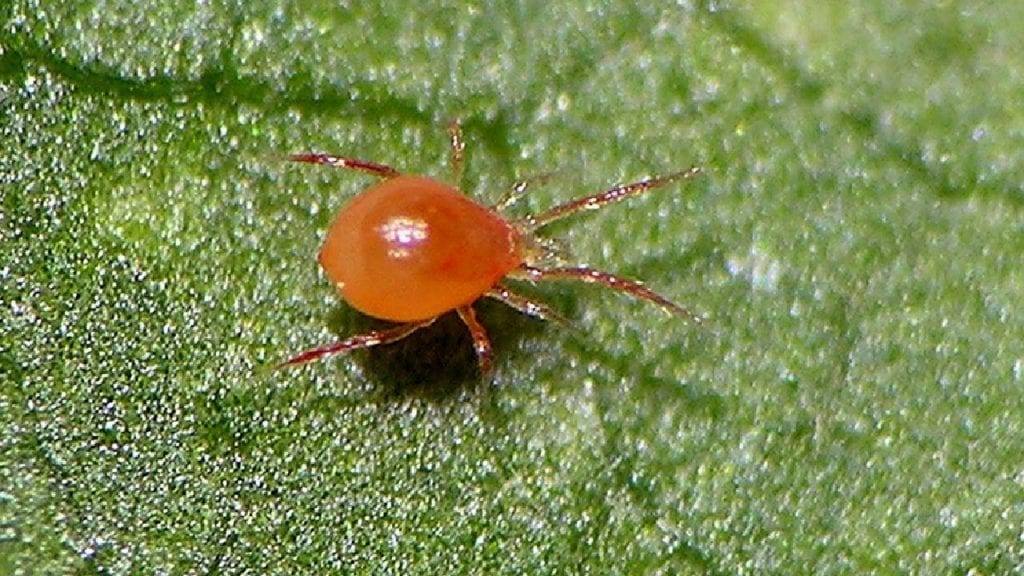
Tetranychus urticae is a bright red 0.5mm red mite that feeds on sage and cellular content of leaves. Indoor crops and high-temperature cultivation areas are their go to locations.
Identification:
- Small dots and white spots on leaves;
- Leaves turn greyish and dull;
- Fine cobwebs on the back of leaves;
- Silk thread covering.
Prevention:
- Cleanse and disinfect crops daily;
- Apply potassium soap and neem oil during the growing period;
- Crushed and diluted garlic;
- Prevent relative environment humidity from surpassing 55%-60%;
- Neoseiulus californicus predatory mites;
- Lower temperatures to 15-16 degrees;
- Remove affected leaves;
- Manually remove spider and spray leaves with cold water.
10. Snails and slugs
Slugs are slimy 1” long with astute antennae whilst snails possess shells. They’re attracted to the tenderest leaves of your cannabis foliage. If left unmanaged, population growths can have tremendously negative outcomes.
Identification:
- Shiny, silver trail on leaves;
- New holes have scalloped edges;
- Chiseled holes;
- Often appear in spring;
- Eat seedling leaves overnight, leaving just a stem.
Prevention:
- Toads, frogs, and beetles predatory prevention;
- Place plastic bottle cloches, eggshells, sawdust, sprinkle lime and diatomaceous earth around the plant;
- Use plastic pots of milk or beer to drown them;
- Place a saucer of salt nearby.
11. Rats and Mice
Common cannabis pests include rodents that scavenge them for food sources.
Identification:
- Concentrated mouse excretion;
- Bite marks;
- Chewed stalks;
- Chewed buds.
Prevention:
- Keep compost in a sealed container;
- Add horse manure;
- Keep overgrowth trimmed;
- Place bird feeders at an unreachable height.
12. Crickets and Grasshoppers
With a high tendency to damage your growing habitat, grasshoppers, and crickets like field crickets and mole crickets are a threat because of their omnivorous nature. These nocturnal creatures feed, particularly on marijuana seedlings. They also target roots and shoots.
Identification:
- Chirping;
- Tunnels or molds in the ground;
- Seedling damage;
- Brown blemishes on plants;
- Other mammals appear.
Prevention:
- Cricket bit and cricket traps;
- Spinosad, Neem Oil, Insecticidal soap, Essentria IC3, and floating row covers;
- Dish soap solution;
- Add nematodes to the soil.
13. Tobacco Mosaic Virus (TMV)
More commonly found in tobacco plants, cannabis plants have also shown the chance of catching it.
Identification:
- Splotchy twisted leaves;
- Mottling mosaic symptoms;
- Reduced yields;
- Slowed growth;
- Uneven stripes of dark and light green;
- Curled leaves with yellow strips.
Prevention:
- Regular inspection;
- Burn all parts of the infected plant.
To conclude
In the duration of your planting, cultivating and harvesting cannabis plants you will come across multiple cannabis viruses, pests, and bugs. However, there are solutions; White Powdery Mildew can be treated with milk, baking soda, neem oil, hydrogen peroxide, and SM-90. Just like birds can be removed via scarecrows and birdfeeders, deer can be kept away via fencing, repellents, sprinklers and scarecrows.
Pesticides, although effective, should be your last resort as they can ruin plant buds. Taking on preventative methods rather than reactive methods will provide you with long-term relief. You can do so by introducing organic restraints or making your grow area as inhospitable to pests, viruses, and bugs as possible.
Table of contents



